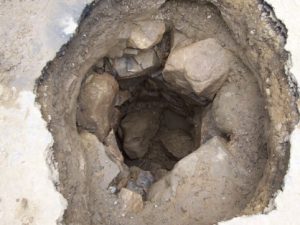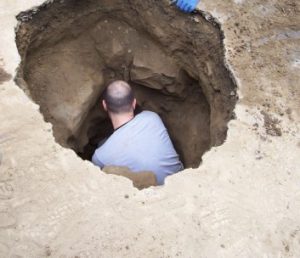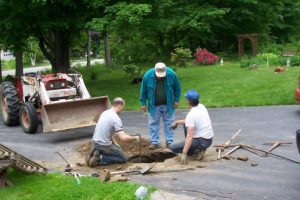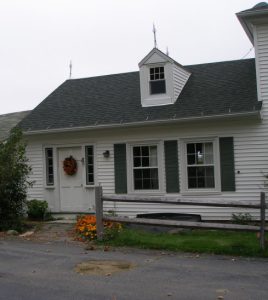Researching family history takes us to many places: libraries, museums, various genealogical repositories (New England Historic Genealogical Society, of course!), cemeteries, and . . . driveways. An historical archaeological adventure is the sort of research that happened when I wasn’t looking!
The dooryard and then the driveway of my old Asa Williams house had always been hard-packed dirt, until in 1979 my father had the chance to have it paved, making it easier to plow in winter and eliminating the usual signs of mud season. If asphalt improved the look of things, it also covered a multitude of landscaping sins. I don’t remember any difficulties with the driveway in the years that I lived here before college, but when I returned as the owner of My Old House things changed.
The paving was still hard and intact when our moving truck arrived and unloaded the day we returned. It presented no difficulties with plowing during the winter. But by spring, a somewhat circular spot appeared, right smack in the middle of the driveway in front of the kitchen windows and head on to the garage door. The earth moved for us then, and all of it downward, sinking an inch or more at a time, rising as the frost heaved it, then sinking again even more.
Out with the shovels and pickaxes, up with the asphalt pieces broken out and scattered around the driveway, and there it was: an old dug well.
That would be THE old well. The well Asa most likely dug right outside the kitchen door for quick access from the house and forge. The well dug into the underlying stream, approximately 15’ deep, lined with boulders in a stacked, circular manner, and filling quite nicely with water.

 We filled it with gravel; it sank and filled with water. We filled it with sand and gravel; it sank and filled with water. We filled it with sand, gravel, and rocks; it sank and filled with water. Obviously, more drastic methods were required, so we dug everything out. Then we brought in the chains and tractor to pull out the original boulders and bigger rocks. And we dug down. After both my husband and son-in-law disappeared into the well hole, shovels and all, as an historic archaeologist looked on accompanied by my daughter, my brother, and two dogs, we thought we had finally dug out enough to refill it with 2” of crushed stone, followed by 80 pounds of quick-setting concrete mix and 2 yards of gravel on top. A thorough soaking set everything. It sinks no more.
We filled it with gravel; it sank and filled with water. We filled it with sand and gravel; it sank and filled with water. We filled it with sand, gravel, and rocks; it sank and filled with water. Obviously, more drastic methods were required, so we dug everything out. Then we brought in the chains and tractor to pull out the original boulders and bigger rocks. And we dug down. After both my husband and son-in-law disappeared into the well hole, shovels and all, as an historic archaeologist looked on accompanied by my daughter, my brother, and two dogs, we thought we had finally dug out enough to refill it with 2” of crushed stone, followed by 80 pounds of quick-setting concrete mix and 2 yards of gravel on top. A thorough soaking set everything. It sinks no more.
 As the historic archaeologist waved goodbye just before we could hand him a shovel, he reminded us to call him if we found anything. We didn’t need to. The only things that came out of that 227+year-old well hole were sand, gravel, water, rocks – and eventually my husband and son-in-law. Not a single valuable archaeological artifact to make us all wealthy. Such is the hallmark of my family research.
As the historic archaeologist waved goodbye just before we could hand him a shovel, he reminded us to call him if we found anything. We didn’t need to. The only things that came out of that 227+year-old well hole were sand, gravel, water, rocks – and eventually my husband and son-in-law. Not a single valuable archaeological artifact to make us all wealthy. Such is the hallmark of my family research.
Now, if you ask me about skeletons or old shoes, black books or Bible stories, horses or herbs, I'll have a different story to tell!
Share this:

About Jan Doerr
Jan Doerr received a B.A. degree in Sociology/Secondary Education from the University of New Hampshire, and spent a long career in the legal profession while researching her family history. She has recently written and published articles for WBUR.org’s Cognoscenti blog: “Labor of Love: Preserving a 226-Year-Old Family Home and Preparing to Let It Go” and “The Value of Family Heirlooms in a Digital Age.” Jan currently lives with her attorney husband in Augusta, Maine, where she serves two Siamese cats and spends all her retirement money propping up a really old house.View all posts by Jan Doerr →
